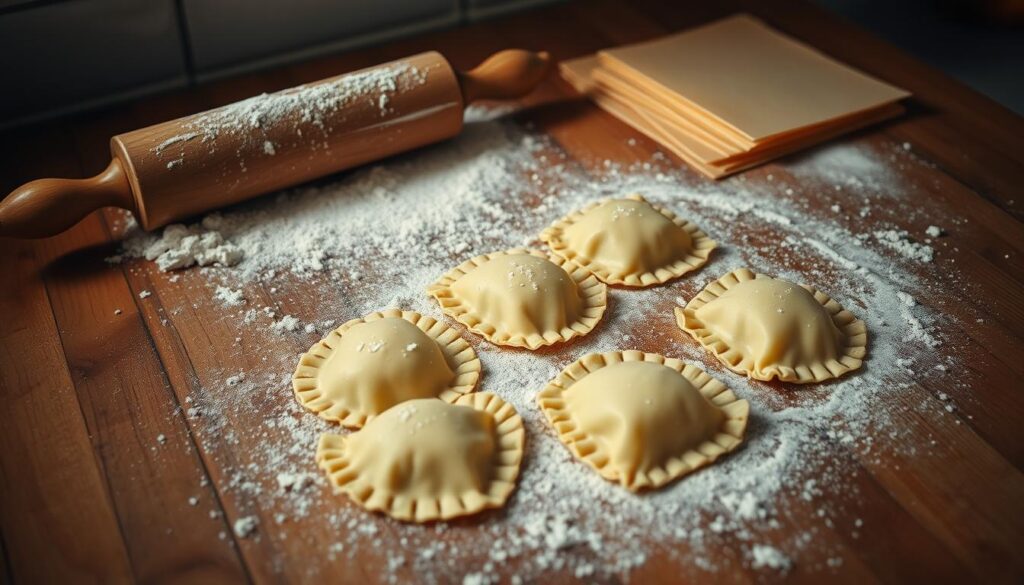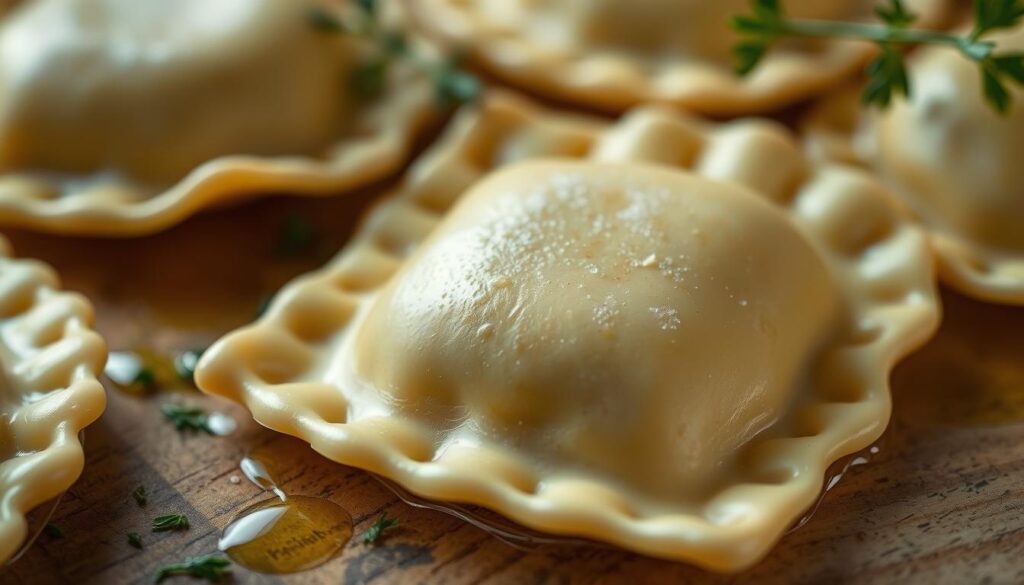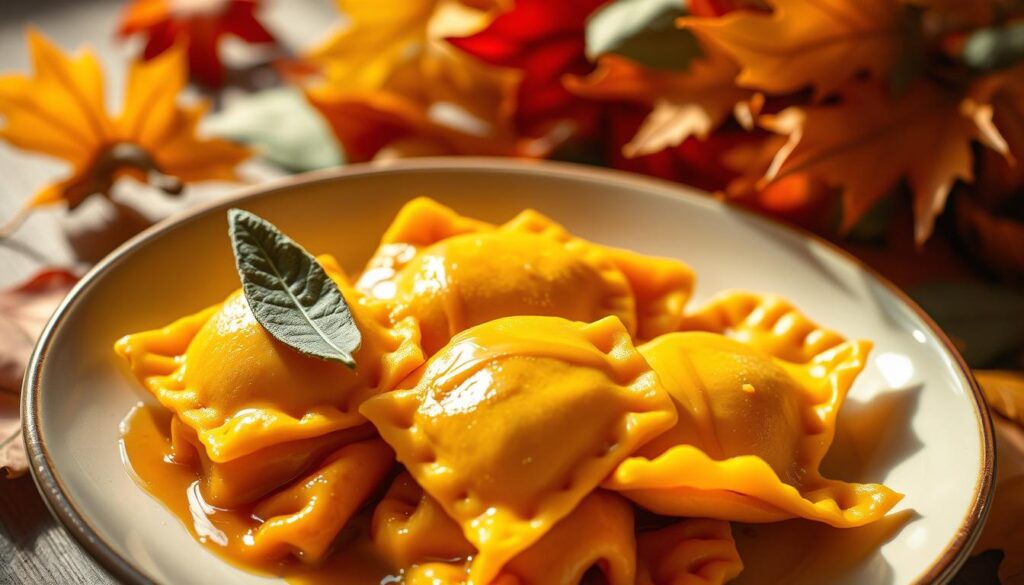As I sit down to write about butternut squash ravioli, I’m reminded of cozy fall and winter nights. Enjoying this dish with loved ones is a special experience. It’s a dish that captures the warmth and comfort of the season.
In this guide, we’ll dive into the world of butternut squash ravioli. We’ll cover its history, the perfect filling, and sauce. Whether you’re a seasoned chef or just starting out, this guide will help you make a memorable dish.
Table of Contents
The History of Butternut Squash Ravioli
Exploring butternut squash ravioli’s history is fascinating. It comes from Northern Italian cuisine, where squash was common. The dish’s story is one of growth, change, and creativity.
Butternut squash ravioli’s recipe has been shared for generations. In the U.S., it’s a favorite, with many restaurants offering their take. The secret to a great dish is the mix of squash sweetness, cheese, and herbs.
Origins in Northern Italian Cuisine
In Northern Italy, this dish is a fall and winter treat. The squash is roasted to enhance its sweetness. Then, it’s wrapped in pasta dough, creating a dish that’s both cozy and refined.
Evolution in American Kitchens
In American kitchens, butternut squash ravioli has grown to include local tastes. Chefs add nuts, seeds, or different cheeses to the filling. This shows how food can unite people across cultures.
Modern Interpretations
Now, butternut squash ravioli is enjoyed globally. From classic Italian recipes to innovative twists, there’s a lot to try. It’s a dish that pleases food lovers and newcomers alike. Its rich history and adaptability make it a favorite worldwide.
| Region | Traditional Ingredients | Modern Variations |
|---|---|---|
| Northern Italy | Butternut squash, cheese, herbs | Nuts, seeds, different types of cheese |
| United States | Butternut squash, cheese, sage | Maple syrup, crispy bacon, caramelized onions |
Essential Ingredients for Perfect Butternut Squash Ravioli
To make tasty butternut ravioli, you need the right ingredients. These include fresh butternut squash, top-notch cheese, and aromatic herbs. Choose ingredients that match the flavor you desire. For example, mixing parmesan and ricotta cheese gives your ravioli a creamy, rich taste.
Understanding each ingredient’s role is key to making great butternut squash ravioli. Here are the main components to think about:
- Fresh butternut squash: It’s the main ingredient, offering a sweet, nutty taste.
- High-quality cheese: A mix of cheeses, like parmesan and ricotta, adds depth and creaminess.
- Fragrant herbs: Fresh herbs like sage and parsley bring a bright, fresh flavor to the dish.
When making your butternut squash ravioli, remember that the quality of your ingredients matters a lot. By picking the best ingredients, you’ll create a dish that’s both delicious and memorable.
Kitchen Tools and Equipment You’ll Need
To make delicious butternut squash ravioli, you’ll need the right tools and equipment. Having the best sauce is crucial. But, you also need the right tools to prepare the dish.
Some essential tools include a pasta machine, a sharp knife, and a cutting board. For filling preparation, you’ll need a food processor, a mixing bowl, and a spoon.
Pasta Making Tools
- Pasta machine
- Sharp knife
- Cutting board
Filling Preparation Equipment
- Food processor
- Mixing bowl
- Spoon
Optional Specialized Gear
While not necessary, some optional tools can make the process easier. These include a ravioli cutter and a pastry brush.
With these tools and equipment, you’ll be well on your way to making delicious butternut squash ravioli. And you’ll have the best sauce for it.
Preparing the Perfect Butternut Squash Filling
To make a tasty butternut squash ravioli, you need the right filling. The best sauce for butternut squash ravioli makes a big difference. But, it all begins with the filling. I focus on the squash type, roasting, and mixing ingredients when preparing butternut squash filling.
Preparing the filling involves a few steps. First, I roast the squash to enhance its sweetness. Then, I blend it with Parmesan cheese, sage, and nutmeg. This mix creates a smooth, creamy filling. Finding the right flavor balance is key for a great best sauce for butternut squash ravioli.
Here are some tips for preparing butternut squash filling:
- Choose a ripe butternut squash for the best flavor.
- Roast the squash in the oven with some olive oil and salt to bring out its natural sweetness.
- Mix the roasted squash with ingredients like Parmesan cheese, sage, and nutmeg.
- Use a food processor to create a smooth and creamy filling.
By following these tips, you can make a delicious butternut squash filling. It will pair perfectly with the best sauce for butternut squash ravioli. Make sure to balance the flavors and textures for a great dish.
| Ingredient | Quantity |
|---|---|
| Butternut squash | 1 medium |
| Parmesan cheese | 1/2 cup |
| Sage | 1 tablespoon |
| Nutmeg | 1/2 teaspoon |
Making Fresh Pasta Dough from Scratch
To make authentic butternut squash ravioli, fresh pasta dough is key. This step needs focus, from picking the right flour to kneading it just right. Adding a brown butter sage sauce makes it a memorable dish.
Choosing the right flour is crucial for pasta dough. Look for flour with high protein for a strong dough. “00” flour or high-protein all-purpose flour works well. The egg to flour ratio also matters for dough texture. Use one large egg for every 100 grams of flour as a starting point.
Choosing the Right Flour
The flour you pick can greatly impact your pasta dough. Here are some tips for selecting flour:
- Protein content: High protein flours like “00” or bread flour are best.
- Texture: Fine-textured flour makes for smooth dough.
- Brand: Choose a reputable pasta flour brand.
Egg to Flour Ratio
The egg to flour ratio is key for pasta dough. Here are some guidelines:
- Use one large egg for every 100 grams of flour.
- Adjust the ratio to get the right dough consistency.
- Adding eggs and water can make the dough more tender.
Kneading Techniques
Kneading is vital for making pasta dough. Here are some kneading tips:
- Knead for at least 10 minutes to develop gluten.
- Use a stand mixer with a dough hook for easier kneading.
- Kneading by hand can add a traditional touch.
By following these tips, you can make fresh pasta dough from scratch. It’s perfect with brown butter sage sauce or your favorite sauce. The result is always delicious.
Rolling and Shaping Your Ravioli
To make perfect butternut squash ravioli, you need to get good at rolling and shaping. It might take some practice, but with the right tools, you’ll get it right. For what sauce for butternut squash ravioli, a light sauce is best. It lets the squash’s flavor stand out.
Here are some tips for rolling and shaping ravioli:
- Use a pasta machine to roll out the dough to the desired thickness.
- Cut out the ravioli shapes using a round cookie cutter or a ravioli cutter.
- Place a small spoonful of the butternut squash filling in the center of each ravioli shape.
- Fold the dough over the filling, pressing the edges together to seal the ravioli.
Be gentle with the dough to avoid a tough texture. With practice, you’ll make beautiful butternut squash ravioli. They’ll impress everyone.

By using these tips, you’ll make a dish that’s tasty and looks great. So, get creative and try different sauces and fillings. Find your favorite what sauce for butternut squash ravioli and rolling and shaping ravioli combination.
| Ravioli Shape | Filling Amount | Sauce Recommendation |
|---|---|---|
| Round | 1-2 teaspoons | Light and creamy |
| Square | 2-3 teaspoons | Herby and aromatic |
Classic Brown Butter Sage Sauce Recipe
To make a tasty butternut squash ravioli sauce, focus on the classic brown butter sage sauce. It’s a favorite in Italian cooking and goes well with butternut squash ravioli.
For a great sauce, use top-notch ingredients. You’ll need:
- Fresh sage leaves
- Unsalted butter
- Garlic
- Salt and pepper
It’s crucial to control the temperature and timing for the perfect brown butter taste. The classic brown butter sage sauce is all about balance, just like butternut squash ravioli sauce.
Here’s a simple recipe to start:
- Melt the butter in a saucepan over medium heat
- Add the sage leaves and garlic, and cook until the butter turns golden brown
- Season with salt and pepper to taste
This classic brown butter sage sauce recipe is a great starting point for your butternut squash ravioli sauce journey. With a bit of practice and patience, you’ll be making delicious sauces like a pro.
Alternative Sauce Options for Butternut Squash Ravioli
When thinking about what sauce for butternut squash ravioli, you have many choices. The classic brown butter sage sauce is loved by many. But, there are also alternative sauce options that can make the dish even better. You can try creamy cheese sauces or light herb sauces for a refreshing twist.
Some popular alternative sauce options for butternut squash ravioli include:
- Creamy garlic sauce
- Light and tangy lemon sauce
- Rich and flavorful mushroom sauce
These sauces can bring a new flavor to your dish. And, they’re easy to make at home with just a few ingredients.
In conclusion, finding the perfect what sauce for butternut squash ravioli is all about trying different alternative sauce options. With a bit of creativity, you can make a dish that will wow everyone. It’s a great way to impress your family and friends.
Professional Tips for Perfect Texture
Making butternut squash ravioli requires perfect texture. It’s key to control the dough, filling, and cooking time. As a pro, I know these details are crucial.
First, the dough must be smooth and pliable. It should not be too sticky or dry. Use the right flour and egg ratio and knead well. For the best texture, mix all-purpose and semolina flour.
Dough Consistency
Here are tips for the perfect dough:
- Use a mix of all-purpose and semolina flour
- Knead for at least 10 minutes to strengthen the dough
- Let the dough rest for 30 minutes to relax the gluten
Filling Moisture Control
It’s also important to control the filling’s moisture. Cook the butternut squash until it’s dry. This prevents the dough from getting soggy. Follow these tips for a delicious texture.

By using these tips, you’ll make ravioli that impresses everyone. Remember, it takes practice to get it right. Don’t give up if it doesn’t work out at first.
| Tips for Perfect Texture | Description |
|---|---|
| Dough Consistency | Use a mix of all-purpose and semolina flour, knead for 10 minutes, and rest for 30 minutes |
| Filling Moisture Control | Cook the butternut squash until it’s dry and season with salt and herbs |
| Cooking Time Precision | Cook the ravioli for 3-5 minutes or until they float to the surface |
Common Mistakes to Avoid
Making butternut squash ravioli can be exciting, but mistakes can ruin it. Here are some common errors to steer clear of. These include overworking the dough and undercooking the ravioli.
Some common mistakes to avoid include:
- Overworking the dough, which can lead to tough, chewy ravioli
- Undercooking the ravioli, which can result in a raw, starchy texture
- Not using enough filling, which can leave the ravioli tasting bland and empty
- Not sealing the ravioli properly, which can cause them to fall apart during cooking
To make perfect butternut squash ravioli, follow the recipe closely. Take your time to prepare each part well. With practice, you’ll master making delicious ravioli without common mistakes.
By avoiding these mistakes, you can make an amazing dish. Butternut squash ravioli’s rich flavor will shine. Whether you’re experienced or new to cooking, getting it right is key.
| Mistake | Consequence | Solution |
|---|---|---|
| Overworking the dough | Tough, chewy ravioli | Work the dough just until it comes together, then let it rest |
| Undercooking the ravioli | Raw, starchy texture | Cook the ravioli for the recommended amount of time, or until they float to the surface |
Wine Pairing Suggestions
Finding the right wine to pair with butternut squash ravioli can make a big difference. The dish’s rich, sweet, and nutty flavors match well with many wines. Here are some top picks:
White Wine Options
For a light and refreshing taste, try these white wines:
- Pino Grigio: its citrus and floral notes complement the sweetness of the butternut squash
- Sauvignon Blanc: its acidity cuts through the richness of the ravioli filling
- Arneis: its subtle nutty flavors enhance the overall flavor profile of the dish
Red Wine Choices
For a bolder taste, consider these red wines:
- Dolcetto: its bright acidity and moderate tannins pair well with the earthy flavors of the butternut squash
- Valpolicella: its moderate acidity and firm tannins complement the richness of the ravioli filling
- Barbera: its bright acidity and moderate tannins enhance the overall flavor profile of the dish
Non-alcoholic Alternatives
If you don’t drink alcohol, try these options. Pair butternut squash ravioli with a sparkling juice, like apple or grapefruit. Or, choose a flavored soda, such as ginger ale or cream soda.
| Wine | Pairing Notes |
|---|---|
| Pino Grigio | Crisp and refreshing, pairs well with sweet and nutty flavors |
| Sauvignon Blanc | Acidic and citrusy, cuts through richness and complements earthy flavors |
| Arneis | Subtle nutty flavors, enhances overall flavor profile |
Seasonal Variations and Adaptations
Exploring butternut squash ravioli, I see it can change with the seasons. To make a tasty dish, I add seasonal variations to the recipe. For instance, in summer, I mix in fresh corn and zucchini for extra flavor and texture.
In fall, roasted butternut squash and sage make the dish warm and cozy. Pairing it with a brown butter sage sauce enhances the squash and pasta’s flavors. Here are some seasonal ideas:
- Summer: fresh corn, zucchini, and basil
- Fall: roasted butternut squash, sage, and brown butter
- Winter: roasted root vegetables, like carrots and parsnips, with a creamy sauce
- Spring: fresh peas, asparagus, and a citrusy sauce
Using these seasonal variations, I craft a unique and tasty butternut squash ravioli. Whether it’s summer veggies or winter roots, the goal is to mix flavors and textures for a dish that’s both comforting and exciting.

Make-Ahead and Storage Guidelines
Planning ahead is key for butternut squash ravioli. Knowing how to freeze, refrigerate, and reheat keeps it fresh and tasty. This way, you can enjoy it whenever you like.
Making ravioli ahead of time saves time, perfect for the holidays. Follow these storage tips to keep your ravioli fresh and delicious. It’s great for any occasion, from special dinners to casual get-togethers.
Freezing Instructions
To freeze, lay uncooked ravioli on a parchment-lined baking sheet. Make sure they don’t touch. Once frozen, put them in an airtight container or freezer bag.
Refrigeration Tips
For use within a day or two, refrigerate your ravioli. Store it in an airtight container, covered with plastic wrap or foil. This prevents drying out.
Reheating Methods
To reheat frozen or refrigerated ravioli, boil it in salted water for 3-5 minutes. It’s ready when it floats. You can also microwave it, but watch it closely to avoid overcooking. These tips help you enjoy your ravioli at any time, keeping its flavor and texture perfect.
Dietary Modifications and Substitutions
Butternut squash ravioli can be made to fit many dietary needs. For those with gluten intolerance, gluten-free pasta is a great substitute. This way, everyone can enjoy the yummy taste of butternut squash ravioli.
Here are some ways to make butternut squash ravioli more inclusive:
- Use vegan filling options, such as tofu or tempeh, for plant-based diets.
- Replace traditional cheese with dairy-free alternatives, like soy cheese or nut-based cheese.
- Opt for gluten-free pasta for those with gluten intolerance or sensitivity.
These modifications make sure everyone can enjoy butternut squash ravioli, no matter their dietary restrictions.
Remember, the secret to great butternut squash ravioli is balancing flavors and textures. With a bit of creativity, you can make a dish that’s both tasty and welcoming to all.
Garnishing and Presentation Ideas
Presenting butternut squash ravioli can make your meal more enjoyable. Here are some ideas to make your dish look great.
Start with classic garnishes like fresh sage leaves or Parmesan cheese. They match the butternut squash ravioli’s taste. For something new, try arranging the ravioli in a pattern or using sauce to draw on the plate.
Traditional Garnishes
- Fresh herbs, such as sage or parsley
- Grated cheese, like Parmesan or ricotta
- Toasted nuts or seeds, such as pine nuts or pumpkin seeds
Modern Plating Techniques
For a creative twist, mix colors and textures on your plate. Add roasted veggies like Brussels sprouts or carrots. Or, use a tasty sauce like brown butter or cream.
Photography Tips
To show off your butternut squash ravioli, use natural light and a simple background. A macro lens can help focus on the dish’s details. Try different angles to make it more interesting.
| Garnish | Presentation Idea | Photography Tip |
|---|---|---|
| Fresh herbs | Arrange ravioli in a pattern | Use natural light |
| Grated cheese | Use a sauce to create a design | Experiment with angles |
| Toasted nuts | Add roasted vegetables | Highlight details with a macro lens |
Conclusion
As we wrap up our journey into butternut squash ravioli, I hope you’re excited to try making it yourself. It might seem hard at first, but with practice, you’ll enjoy a special meal.
Feel free to stick to classic recipes or try new flavors. Butternut squash ravioli pairs well with many sauces, from brown butter to fruit and nuts. It’s a versatile dish that lets you get creative.
Keep practicing and remember to have fun. Cooking is about making something unique and delicious. Butternut squash ravioli is a great way to express your creativity in the kitchen.
So, get your ingredients ready, and let’s make some butternut squash ravioli together. Enjoy the flavors of this Italian favorite!



